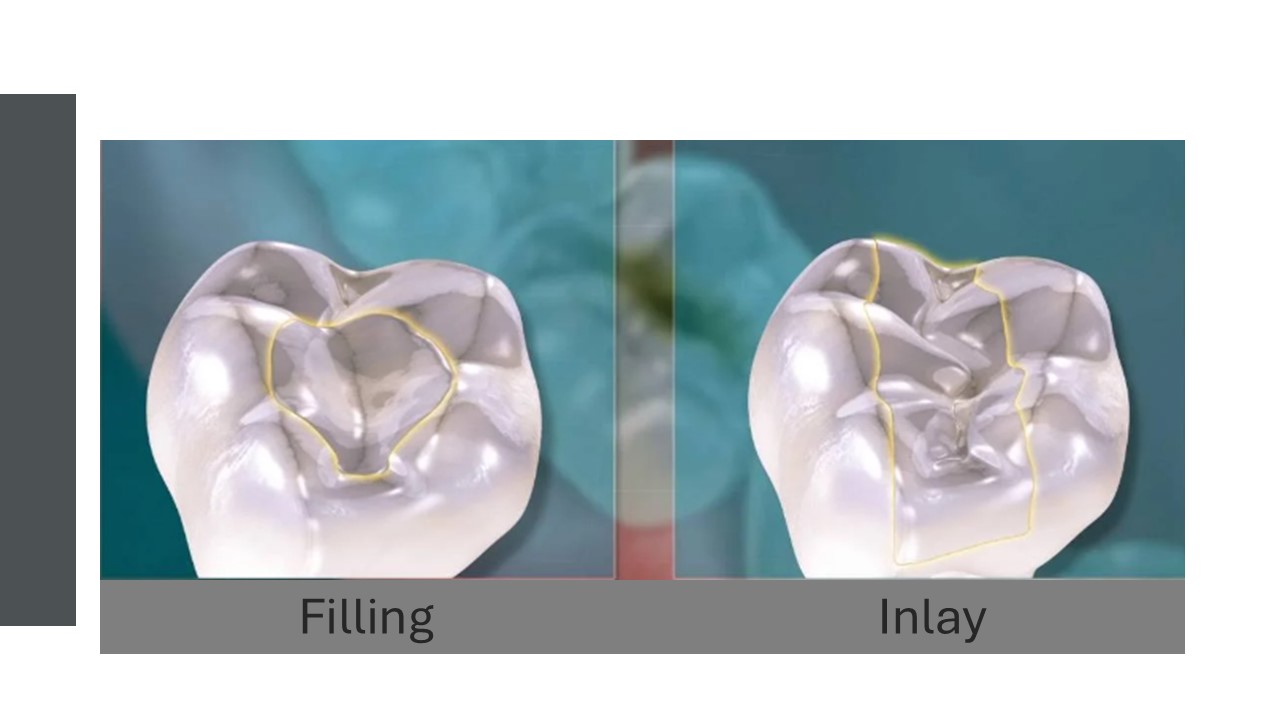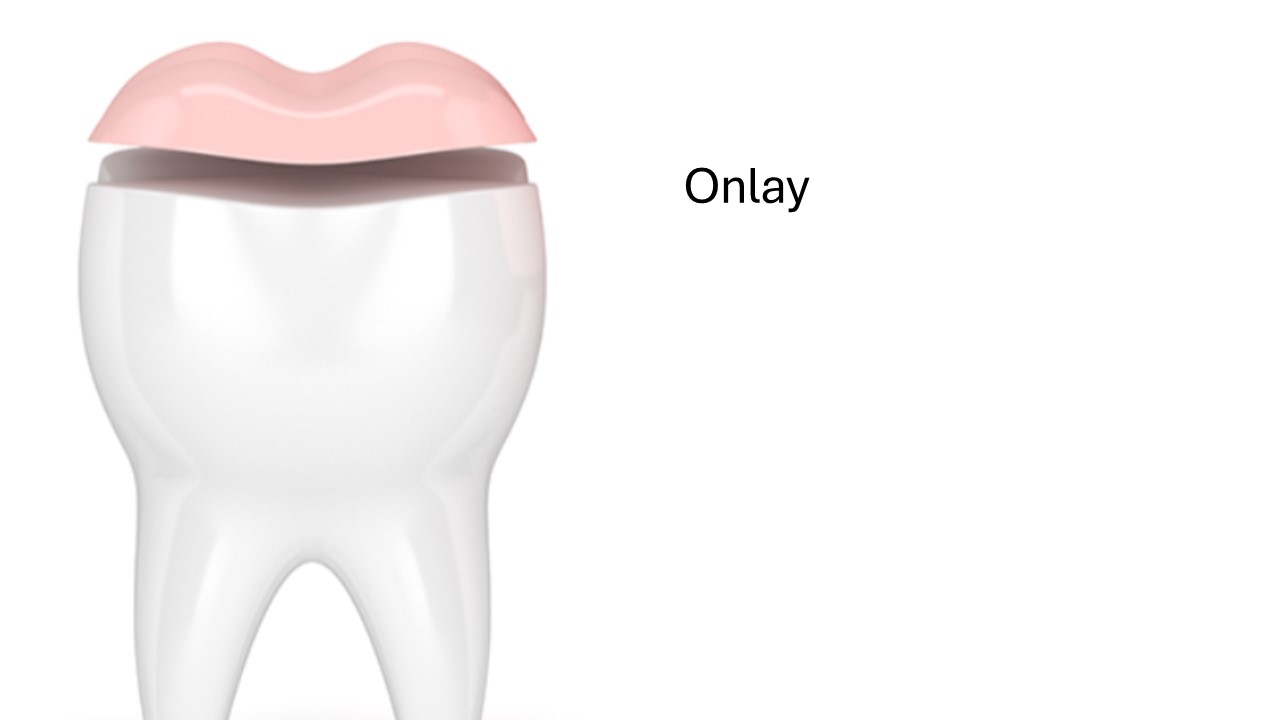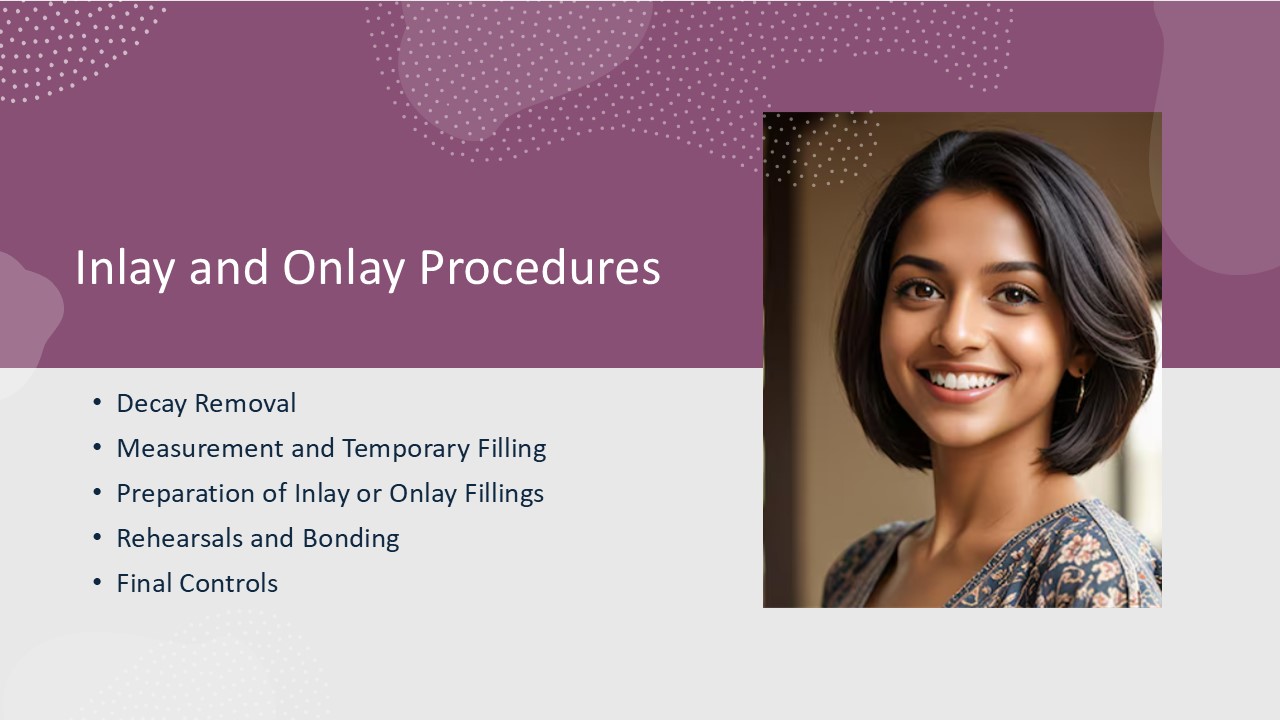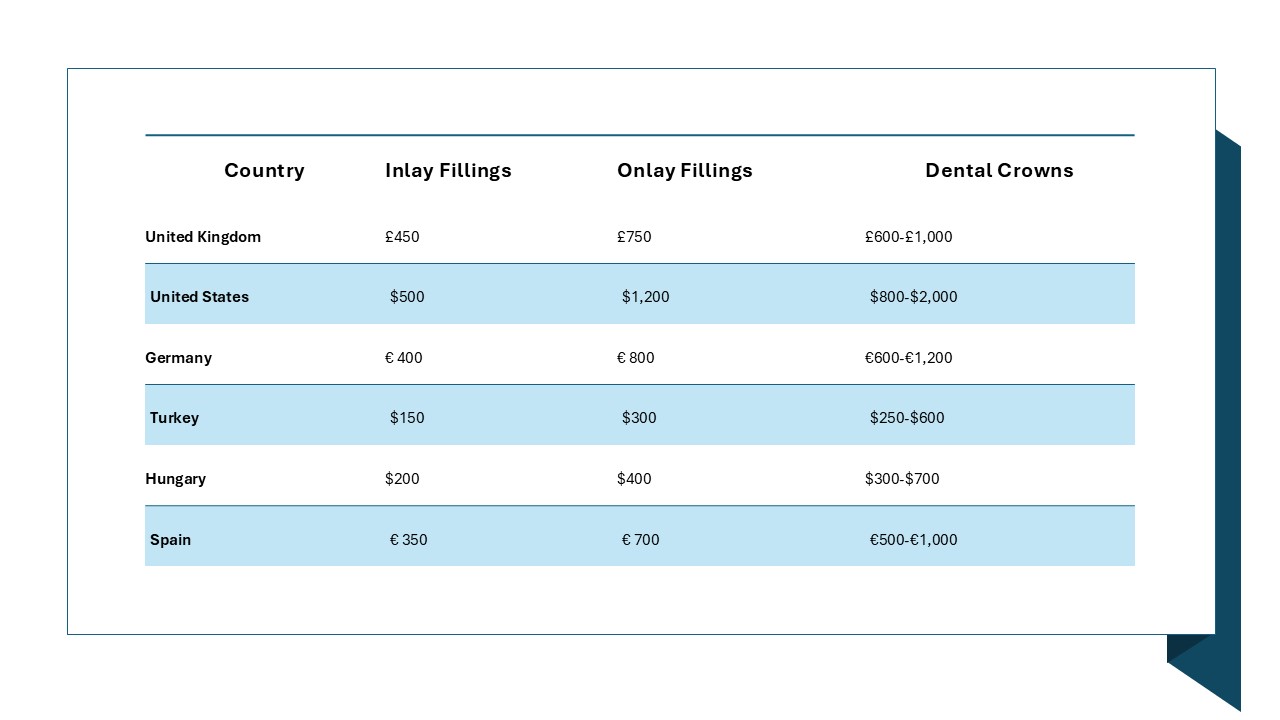
There are three separate methods used in molars fillings to protect the natural tooth and provide the maximum strength. The scope and extent of the surgery determine the best course of action, between Inlay onlay vs crown.
For smaller cavities (where caries is found between the tooth cusps, called tubercles), inlay fillings are usually the way to go. On the other hand, onlay restoration is used when treatment involves tooth peaks known as tubercles. After root canal therapy, the tooth loses vitality, and its nerves die along with it. In such a case, a dental crown is the best option for a more complete restoration.
What is an inlay and when should you get one?
Inlay fillings are laboratory-fabricated restorations placed to the occlusal surfaces of teeth. These fillings are fabricated in the laboratory following the acquisition of 3D data using intraoral scanning technologies. Inlay fillings are significant both functionally and aesthetically. Consequently, they are manufactured with porcelain composite.
To apply these fillings, the tooth's overall structure must be maintained, and the nerves must remain undamaged. For this filling to be applicable, the decay must be confined to the upper layer of the tooth and must not penetrate deeply enough to impact the scale share.
What are the pros and cons of inlays?

The following are the main advantages and disadvantages of inlay fillings:
Pros of inlay fillings:
- The use of colorants, composite resin, and porcelain in inlay fillings allows them to imitate the color of real teeth.
- Because it contains porcelain, hybrid composite is quite durable component.
- It does not fracture and result in total tooth loss subsequent to the therapy.
- The hardness and strength values of the inlay fillings are markedly superior to those of amalgams and direct applications due to the laboratory preparation process.
Cons of inlay treatment:
- Inlay fillings are costlier procedures than conventional fillings.
- Due to their preparation in a laboratory setting, inlay fillings may necessitate multiple clinical appointments based on the treatment protocol.
- Inlay fillings may be inappropriate for extensive restorations.
What is an onlay and when is it recommended?

Basically, you can think of an onlay filling as an alternative to dental crowns. These fillings encompass the whole occlusal surface of the tooth yet are administered without any damage to the tooth structure, unlike dental crowns.
Onlay fillings are utilized for greater diameter dental cavities or tooth damage, in contrast to inlay applications. These fillings are made of hybrid composite materials fabricated in a laboratory environment utilizing porcelain and composite.
The production of a filler in a laboratory setting enables it to attain optimal color and strength characteristics more effectively. In this regard, onlay fillings are highly durable and aesthetically harmonious with natural teeth.
What are the advantages and disadvantages of onlays?
The primary benefits and drawbacks of onlay fillings are as follows.
Pros of onlay fillings
- Onlay fillings retain the original tooth structure by addressing only the affected region without any removal of the tooth surface.
- Onlay fillings demonstrate durability, with a success rate of 90% at five years, 89% at eight years, and 85% at ten years, as per a scientific study conducted in 2019.
- Despite being a large-scale repair, the treatments are quite effective both visually and functionally.
Cons of onlay fillings
- Onlay crowns, lacking lateral coverage like dental crowns, may insufficiently preserve weaker teeth in extensive restorations.
- Onlay fillings are costly procedures, typically comparable in price to dental crowns.
What is a dental crown and when should you get one?

A dental crown is a prosthetic covering that encases the tooth entirely. Dental crowns are recognized as invasive dental procedures that involve significant abrasion of the tooth surface. Crowns safeguard the tooth from external factors by encasing it completely. Crowns are favored in instances where the tooth is significantly compromised, particularly from the lateral aspects, in large diameter restorations, even in the absence of root canal therapy.
The total removal of the pulp during root canal treatments deprives the tooth of nourishment, resulting in a loss of vitality, hence making crowns the predominant solution in most cases.
What are the benefits and drawbacks of dental crowns?
The main advantages and disadvantages of dental crowns are as follows.
Pros of dental crowns:
- Dental crowns offer strong shielding as they encase the tooth entirely.
- Due to the comprehensive adhesion of dental crowns to the tooth, issues such as dislodgement or fracture are relatively uncommon.
- Crowns utilized in aesthetic dentistry include zirconia, porcelain, or metal-supported (PFM) options that can attain the requisite functional and cosmetic outcomes.
- Dental crowns alleviate excessive masticatory strain on the lateral teeth.
Cons of dental crowns:
- The primary drawback of dental crowns is the substantial removal of tooth structure required. The extent of scraping may reach 1 mm in porcelain crowns and 1.5 mm in zirconia and PFM (Porcelain) crowns.
- Despite the longevity of dental crowns, particularly porcelain crowns may exhibit discoloration prior to their lifespan's conclusion, necessitating replacement.
How to choose between inlay, onlay, and crown: key differences
The decision to apply an inlay onlay vs crown is made after the damaged region of the tooth surface has been cleansed. A little black spot on the tooth surface may conceal a substantial area that extends significantly deeper. On the other hand, extensive black patches on the tooth surface may be effective in a far more confined area. So, the treatment to be administered is determined following the cleansing of the affected tooth.
How do inlays, onlays, and crowns compare in terms of durability?
All three forms of treatment are quite durable. A crown typically endures for approximately 20 years, whereas inlay and onlay fillings exhibit an 85% survival rate after a decade of monitoring.
What are the cost differences between inlays, onlays, and crowns?
Inlay fillings are less expensive procedures as they necessiate limited interventions. Nonetheless, the treatment costs for Onlay and Crown procedures are quite similar. Most clinics provide both treatments at an identical price to avert patients from making erroneous decisions based on cost.
How do aesthetic differences affect your choice?
Inlay and onlay fillings are fabricated in a natural hue that precisely corresponds to the natural tooth color, as they are manufactured in a laboratory setting. It is feasible to achieve the required hue for composite fillings in a laboratory setting, allowing for color transitions between white and grey tones based on the tooth structure.
Dental crowns on the other hand, are chosen through the brand's shade. Consequently, while dental crowns yield satisfactory aesthetic outcomes, they do not achieve the same level of natural aesthetics as onlay fillings.
How are inlays, onlays, and crowns placed?
While tha application of Onlay and Inlay fillings are identical to each other the dental crowns are quite different from them.
How is an inlay and onlay procedure performed?

Inlay and Onlay fillings follow the same procedure. For these procedures, you typically expect 5 different procedures.
1. Decay removal:
Initially, all affected regions of the tooth are meticulously cleansed using diamond burs and curettes. During dental cleaning, particularly in quickly advancing instances known as white caries, deep regions of the dentin layer may be infected despite being undetectable on X-ray. In such instances, the tooth is subjected to a more thorough cleaning to guarantee the total eradication of the infection.
2. Measurement and temporary filling;
Measurements are conducted through intraoral scanning equipment or wax. Upon completion of the measurement, the patient is discharged, and the data is forwarded to the laboratory.
3. Preparation of inlay or onlay fillings;
Inlay and onlay fillings are often fabricated and implemented as indirect restorations. However, there are direct applications in which the composite resin is put directly to the tooth surface. Still, due to the substantial thickness of inlay and onlay fillings, attaining the requisite aesthetic and structural properties in direct applications is exceedingly challenging. The laboratory-prepared fillings are hybrid composites reinforced with porcelain, yielding superior aesthetic outcomes.
4. Rehearsals and Bonding;
Upon completion of the laboratory studies, the fillings are evaluated within the patient's oral cavity, and requisite adjustments are implemented. If the clinic lacks in-house laboratory facilities, the patient must return the next day for each rehearsal.
5. Final controls;
Once the fillings are adhered, both minor and significant enhancements can be implemented. These enhancements are typically implemented to facilitate the harmonic function of the tooth in conjunction with adjacent teeth.
How is a dental crown prepared and placed?
Crowns are not composed of composite materials, unlike fillings instead they come in as an solid cube form. Crowns are preferred in cases such as root canal therapy or when the lateral walls of the tooth are damaged. The procedural stages in post-filling crown treatments are as follows:
1. Cleaning the decay
The initial step in crown placement following a filling is the excision of deterioration. The deterioration disseminates across an extensive region.
2. Tooth shaving and temporary crown
To place the crowns, the tooth is thinned on all sides. The amount of abrasşon varies between 0.7 and 1.5 mm, depending on the type of material to be used. A temporary crown is subsequently affixed, and the patient is released.
3. Inserting the permanent crown:
The patient is summoned for a second appointment, during which the permanent crown, fabricated according to the previously obtained measurements, is affixed to the patient.
How much do inlays, onlays, and crowns cost?

Below you can examine the prices of Inlay onlay and Crows in several nations.
|
Country |
Inlay Fillings |
Onlay Fillings |
Dental Crowns |
|
United Kingdom |
£450 |
£750 |
£600-£1,000 |
|
United States |
$500 |
$1,200 |
$800-$2,000 |
|
Germany |
€ 400 |
€ 800 |
€600-€1,200 |
|
Turkey |
$150 |
$300 |
$250-$600 |
|
Hungary |
$200 |
$400 |
$300-$700 |
|
Spain |
€ 350 |
€ 700 |
€500-€1,000 |
How do inlays, onlays, and crowns look and function?
Inlay and onlay fillings are laboratory-fabricated restorations that can replicate the natural color of teeth. Actually, new imaging technology enable these fillings to replicate the dark and light tones found in genuine teeth. The porcelain utilized in these fillings results in exceptionally strong and long-lasting restorations.
How do they affect bite force and functionality?
Inlay and onlay restorations can achieve an ideal congruence with natural dentition. This is due to the fact that these fillings enable minor adjustments following the application.
Which option is better for front teeth vs back teeth?
A comprehensive filling procedure on the anterior teeth generally leads to considerable structural compromise of the tooth. Consequently, it is essential that crowns are favored for comprehensive restorations on these teeth. Moreover, anterior teeth are inappropriate for inlay and onlay restorations.
FAQs: inlay, onlay, and crown
Below, you can find frequently asked questions and answers regarding inlay, onlay, and crown treatments.
What is the difference between an inlay and a filling?
A regular filling and an inlay filling necessitate an identical procedure till the tooth is sanitized. The procedure for ordinary fillings is performed on the tooth. In inlay fillings, the filling fabricated based on measurements obtained in a laboratory setting is inserted.
How long does each treatment last?
The typical lifespan of Inlay and Onlay fillings is 15 to 20 years. At the conclusion of this period, despite the filling retaining its strength, it necessitates replacement owing to discoloration.
Which treatment is best for a cracked tooth?
Inlay and onlay procedures are effectively utilized for acrowded dentition. Placing crowns in these regions presents challenges regarding the proper contact between the crown and the gum, as well as its compatibility with the adjacent teeth.
Can inlays or onlays be replaced easily?
Inlay and onlay procedures are effectively utilized for crowded dentition. Placing crowns in these regions presents challenges regarding the proper contact between the crown and the gum, as well as its compatibility with the adjacent teeth.
Are crowns more expensive than inlays or onlays?
Crowns are costlier than inlay fillings, however they are comparable in price to onlay fillings. Nevertheless, most clinics provide same pricing for both treatments to avert the possibility of patients making erroneous decisions based on cost..
How painful are these procedures?
Inlay, onlay, and crown procedures are conducted under local anesthesia, hence resulting in no pain or discomfort. Nonetheless, general anaesthesia is often favored, particularly for crowns, contingent upon the patient's tolerance for fear.
What is the recovery time after treatment?
After inlay and onlay fillings, you may resume your normal activities within a few hours as the anesthesia dissipates. Following the placement of crowns, you may have sensitivity to thermal stimuli for around one week. This sensitivity then dissipates.
How to choose between inlay, onlay, and crown?
If the damage to the tooth surface encompasses the entire outer layer, an onlay filling is recommended. Nonetheless, if the decay is confined to a restricted region between the cusps at the apex of the tooth, an inlay restoration is favored.
Do these treatments require special care?
These fillings are created at the junctions where the layers of the tooth converge during its creation, known as fissures. If these fissured areas are not well cleansed post-treatment, they may retain germs and facilitate the onset of caries. Consequently, it is important to emphasize that the upper surfaces of the teeth are brushed with greater diligence following treatment. Consult your dentist to obtain a fissure sealant for your additional treated teeth.
Is it possible to whiten teeth with inlays, onlays, or crowns?
Inlay and onlay restorations are unresponsive to whitening procedures. As the dentin layer beneath these fillings is thoroughly cleansed, hydrogen peroxide agents are unable to infiltrate the region and perform the whitening function.
Are there any risks associated with inlays, onlays, or crowns?
An effective and uncomplicated inlay, onlay, or crown procedure entails no hazards. Nevertheless, in restorative procedures, dentists may be unable to entirely eradicate the infection as it is not visible on X-ray imaging. In such instances, the infection may persist post-treatment and necessitate a continuation of the therapy.
How to know if i need an inlay, onlay, or crown?
The determination of whether an Inlay, Onlay, or Crown is necessary may only occur after the caries has been eradicated. It is inappropriate to preemptively forecast which treatment will be administered.
Can you eat normally after getting an inlay, onlay, or crown?
You may resume your regular eating habits once the effects of the anesthetic have fully dissipated following the treatment.
Which one is more durable: crown or onlay?
Crowns have a longer lifespan than onlay fillings. Onlay fillings has a longevity comparable to that of crown procedures. Crown procedures often last 15 to 20 years, but onlay fillings generally endure for 12 to 18 years.
Final thoughts
Filling procedures are the most commonly employed interventions in dentistry, and all dentists possess expertise in this domain. Nonetheless, filling treatments are also the procedures where the highest number of errors occur. For these treatments to succeed, the clinic must possess advanced X-ray equipment and a skilled dentist capable of accurately assessing the decay and identifying the damaged areas.
At Antlara Dental, we regard tooth fillings as equivalent to the most intricate procedures. Efficacy in the long run is given more weight than short-term satisfaction by these treatments for us. We truly care about your health and well-being, which is why we make it a priority.
